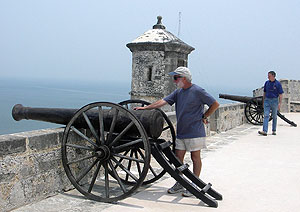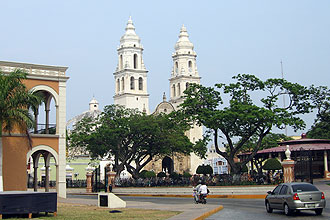 In 1517, Spanish explorers, led by Hernandez de Cordova, set sail from Cuba to search for new lands. Their first landing was at the Mayan village of Catoche, in the Yucatan Peninsula, where the natives greeted them with an ambush and drove them back to sea. After fifteen days without adequate supplies or water they ventured ashore again, this time at Ah Kin Pech, the principal town of the Mayas. Here, what seemed to begin as a friendly welcome turned into a simple choice—the high priest of the village set fire to a pile of reeds and told the sailors if they were not back to their boats before the blaze burned out, they would be used to rekindle the flames.
In 1517, Spanish explorers, led by Hernandez de Cordova, set sail from Cuba to search for new lands. Their first landing was at the Mayan village of Catoche, in the Yucatan Peninsula, where the natives greeted them with an ambush and drove them back to sea. After fifteen days without adequate supplies or water they ventured ashore again, this time at Ah Kin Pech, the principal town of the Mayas. Here, what seemed to begin as a friendly welcome turned into a simple choice—the high priest of the village set fire to a pile of reeds and told the sailors if they were not back to their boats before the blaze burned out, they would be used to rekindle the flames.Back at sea, the Spanish sailors worked their way down the coast until they arrived at Champotón. Locating food and water, they found themselves surrounded by Mayan warriors who paid close attention to Captain Cordova, filling him with ten arrows that would, after five agonizing days, claim his life.
In 1541, after the Mayans were finally subdued, Ah Kin Pech, became the Spanish town of Campeche. Before long, Campeche grew to be one of the richest cities in Mexico.
 One commodity that led to this boom was the logwood tree. Profiteers quickly learned that the tree was the natives’ source of the rich violet and black dyes used to color their textiles. In Europe, these hues were produced by indigo, exotic and affordable only to the rich. Logwood dye provided a less-expensive alternative.
One commodity that led to this boom was the logwood tree. Profiteers quickly learned that the tree was the natives’ source of the rich violet and black dyes used to color their textiles. In Europe, these hues were produced by indigo, exotic and affordable only to the rich. Logwood dye provided a less-expensive alternative. The city thrived as ships filled with logwood sailed back to Spain. The success of this business caught the attention of a particular group of people—pirates. The pirates, including Henry Morgan and Francis Drake, were privateers holding commissions from the English monarchs, who understood that fifty tons of logwood in a single trip would fetch more than a year’s worth of other cargo. So, Campeche became a target for attacks by pirates, forcing officials to erect giant walls to protect against raids.
Wealth not stolen was put toward construction of the splendid colonial architecture which can still be seen. In 1999 Campeche was named a UNESCO World Heritage site.
Click Here for information on our Yucatan & Chiapas Tours.


